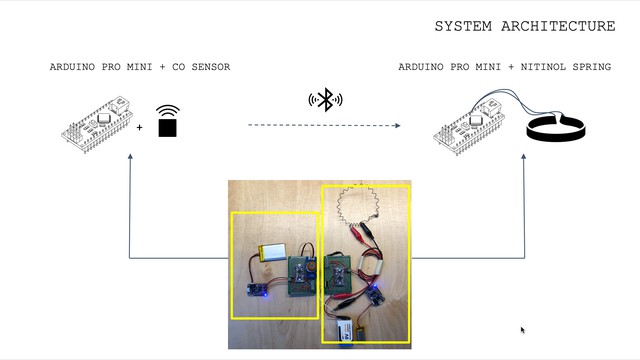Haptic air pollution bracelet 2019, United Kingdom, London
Can a wearable device enhance engagement with air pollution data by providing haptic feedback?



This project explores personal exposure to air pollution via a wearable device and whether haptic feedback can enhance engagement with air pollution data. A wearable was designed to generate squeezing sensations on the user’s wrist when unsafe pollution levels are detected using shape memory alloys. The methodology is divided into two main parts. The first part consists of the technical design process of the device. This involves investigating how to develop a device that generates squeezing feedback, followed by iterative prototyping of the device. The second part consists of the analytical investigations carried out using the final prototype developed in the design process. The investigations include a study to determine the minimum power and duration of the squeezing feedback that a user can feel. This is followed by individual interviews carried out to gather responses to the research question and general thoughts about the device.
Air pollution is one of the most significant environmental factors that impacts negatively on the day-to-day existence and long-term health of the urban population. A recent study by King’s College London revealed that nearly 9,500 people die a year as a result of air pollution in London alone. Providing air pollution information to individuals enables them to understand and improve the air quality of their living environments. A wearable was designed that generates squeezing sensations on the user’s wrist when when unsafe pollution levels are detected using shape memory alloys. The starting point for the design process was to investigate how to develop a device that generates squeezing feedback. Shape memory alloys (SMAs) are special materials that have the ability to deform to a pre-set shape when heated. In line with this research, I investigated the use of shape memory alloys to generate squeezing feedback on the wrist. This project uses a Nitinol spring, a commercially available Nickel-Titanium SMA that contracts like muscles when electrically driven. Other SMAs were tested such as Flexinol®, but the squeezing sensations produced were weak in comparison to the Nitinol springs. The material investigations were carried out in parallel with the prototype design iterations. A study was conducted to determine the minimum power and duration of the squeezing feedback that a user can feel. Three types of squeezing stimuli are applied, each with a different power supply, for durations of 2s, 4s, and 6s respectively. The experiment ended after each stimulus was applied five times. A gap of 20s was applied between consecutive stimuli to ensure that the spring returned to the ambient temperature. Nine participants (4 female, age 21-28) took part. Participants wore the spring on their right wrist with the arm rested in a table and hidden from their view. During the study they responded Yes after every stimulus that was felt. Almost of participants felt four or more of the five stimuli with 9V power supply applied for a duration of 4s. This stimulus was felt by the majority of the population in comparison to the other stimuli and is therefore taken as the squeeze detection threshold. These settings were used to program the final prototype. This stimulus was felt by the majority of the population in comparison to the other stimuli and is therefore taken as the squeeze detection threshold. These settings were used to program the final prototype. Many people mentioned that there is a lack of exposure to air pollution data and that as a result, they are unaware of it and the negative implications associated with it. In addition to this, they mentioned that because the currently available data is averaged over large areas it’s neither useful nor impactful. They felt that this device would increase their awareness of air pollution, as it does not require active user participation and the feedback is real-time.
Details
Team members : Serena Dosanjh
Supervisor : Associate Professor: Ava Fatah gen Schieck
Institution : Bartlett School of Architecture, University college London
Descriptions
Technical Concept : The bracelet was designed and tested through iterative prototype process. The final prototype uses a 20-coil Nitinol spring. The system consists of two separate components. Component one (LHS) consists of an Arduino Pro Mini connected to CO sensor and a HC-05 Bluetooth module in master mode. Component one sends a signal via Bluetooth to component two if the concentration of CO detected is above a certain threshold. Component two (RHS) consists of the spring connected via crimps to a hook that ties around the user’s wrist. The spring connects to the driving circuit from two locations (four coils apart). The circuit consists of a HC-05 Bluetooth device in slave mode connected to an Arduino Pro Mini that supplies PWM pulses (if it receives a signal from component one) to drive a mosfet, which in turn drives the SMA spring.
Credits
Serena Dosanjh
Serena Dosanjh
Serena Dosanjh